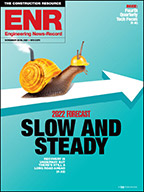The new year will be the year of mobility; construction's Technology Spring, when the constraints on the flow of data into and out of the field, and the use of mobile devices to collect, share and present it, give way for good.
That is one of the expectations of ENR technology editors and they prepare for the year ahead by trying to anticipate where current trends will lead.
Expect to see field deployment of technology gather steam at companies as a driving force to efficiency gains and process innovation.
Watch for wireless networks, technology kiosks and pads, and tablets to sprout on more and more jobsites, so crafts workers can consult the latest shop drawings or models for insight and alerts to late changes, and offer feedback to catch and correct misunderstandings.
The value chain has been joined from one end of the project delivery process to the other, thanks to the connecting links of improved data acquisition devices and management systems, information integration techniques and mobilized data exchange. Expect to see companies capitalize on it.
Look for CIOs and CTOs to try to modulate the revolution. They already are focused on integrating just enough of the right technologies into the right places in the workflow to enhance project delivery, without getting bogged down by gizmos and gadgets, and they will try to stay that way. But they also are driven by the need to help their companies maintain competitive edge in a time when successful engagement with technology is seen as a performance metric and market differentiator. They cannot be bulwarks of resistance; they will have to be agents for change.
Expect some current disruptions to ease. The roiling of the waters caused by the user-driven introduction of iPhones and iPads to the workforce will be calmed as relatively inexpensive Tablet PCs running Android and the forthcoming Windows 8, challenge Apple's iPad and iPhone for business use in the field. Incoming devices will be more powerful and flexible. They will better suit industry needs and will help tear down barriers to mobilizing information, the delivery of software as a service and the storage and management of project data in the cloud.
Yet the next generation of tablets and pads also will offer new challenges for users and technology managers to harness and maintain. Expect more powerful Quad-core tablets early this year and more powerful apps developed to take advantage of them.
As apps increase in performance, some prices will increase, but independently created and relatively inexpensive apps will continue to compete with, and sometimes challenge the capabilities of more expensive, old-school, licensed software. This should add competition to the marketplace and give some smaller companies access to more sophisticated functionality than they previously could afford.
The "bring your own device" battle also will be won by IT managers—not because they have dug in their heels and resisted successfully, but because the devices they support will improve to the point where users actually want them.



Post a comment to this article
Report Abusive Comment